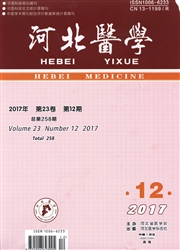

 中文摘要:
中文摘要:
目的:分析急性非ST段抬高型心肌梗死( NSTEMI )患者心电图与冠状动脉造影结果之间的关系,为临床医生预测病情提供理论依据。方法:回顾分析2010年12月至2014年12月83例NSTEMI患者心电图及冠状动脉造影资料,根据胸前导联ST段是否压低分为压低组(64例)和无压低组(20例)。结果:83例患者共发现189支病变血管,其中近段病变血管数81支(42.86%)、中段病变血管数72支(38.10%)和远段病变血管数36支(19.04%);狭窄50%-74%共66支(34.92%)、狭窄75%-90%共42支(22.22%)、狭窄>90%共81支(42.86%);单支血管受累21例、双支血管受累25例和多支血管受累37例。两组NSTEMI患者在近段、中段、远段病变血管数相似,差异无统计学意义( P〉0.05)。NSTEMI压低组患者血管狭窄程度重于无压低组,多支病变血管数目多于无压低组,差异有统计学意义( P〈0.05)。结论:NSTEMI患者胸前导联显示ST段压低,提示冠状动脉狭窄程度重于无压低患者,多支病变血管数目多于无压低组,对判定患者病情程度具有重要意义。
 英文摘要:
英文摘要:
Objective:To analyze the relationship between the electrocardiogram ( ECG) and coronary arteriogram in patients with acute non ST-segment elevation myocardial infarction ( NSTEMI) , and to provide theoretic foundations for clinicians to predict the outcomes. Methods: The data of ECG and coronary arterio-grams of 83 NSTEMI patients treated between December 2010 and December 2014 were retrospectively ana-lyzed. The patients were divided into depression group (64 patients) and depression-free group (20 patients) according to the presence or absence of ST segment depression of the precordial leads. Results:A total of 189 vessels diseased were found in 83 patients, among which, 81 vessels ( 42. 86%) were proximal, 72 vessels (38.10%) were in the middle, and 36 vessels (19.04%) were distal. A total of 66 vessels (34.92%) had 50% -74%stenosis, a total of 42 vessels (22.22%) had 75% -90%stenosis, and a total of 81 vessels (42. 86%) had >90% stenosis. A total of 21 patients had single vessels involved, 25 patients had two vessels in-volved, and 37 patients had multiple vessels involved. The NSTEMI patients of the two groups had similar numbers of vessels disease of the proximal, middle, and distal segments, and the differences were statistically insignificant ( P〉0.05) . The NSTEMI patients of the depression group had significantly severer angiostegnosis and greater number of multiple vessels diseased than the depression-free group, and the differences were sta-tistically significant ( P〈0.05) . Conclusion:ST segment depression as manifested by ECG of precordial leads in NSTEMI patients suggests severer coronary stenosis and greater number of multiple vessels diseased than the depression-free group, which has important significances to judge the pathogenetic conditions of the patients.
 同期刊论文项目
同期刊论文项目
 同项目期刊论文
同项目期刊论文
 期刊信息
期刊信息
